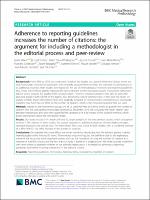| dc.contributor | Vall d'Hebron Barcelona Hospital Campus |
| dc.contributor.author | Vilaró, Marta |
| dc.contributor.author | Selva O'Callaghan, Albert |
| dc.contributor.author | Urrutia, Agustín |
| dc.contributor.author | Ribera, Josep-Maria |
| dc.contributor.author | Cardellach, Francesc |
| dc.contributor.author | Vilardell Tarres, Miguel |
| dc.contributor.author | Cortés, Jordi |
| dc.date.accessioned | 2019-08-01T08:06:31Z |
| dc.date.available | 2019-08-01T08:06:31Z |
| dc.date.issued | 2019-05-31 |
| dc.identifier.citation | Vilaró M, Cortés J, Selva-O’Callaghan A, Urrutia A, Ribera J-M, Cardellach F, et al. Adherence to reporting guidelines increases the number of citations: the argument for including a methodologist in the editorial process and peer-review. BMC Med Res Methodol. 2019;19(1):112. |
| dc.identifier.issn | 1471-2288 |
| dc.identifier.uri | https://hdl.handle.net/11351/4230 |
| dc.description | Nombre de citacions; Avaluació d'experts; Directrius pels informes |
| dc.language.iso | eng |
| dc.publisher | BMC |
| dc.relation.ispartofseries | BMC Medical Research Methodology;19(1) |
| dc.rights | Attribution 4.0 International |
| dc.rights.uri | http://creativecommons.org/licenses/by/4.0/ |
| dc.source | Scientia |
| dc.subject | Edició universitària - Metodologia |
| dc.subject | Bibliometria |
| dc.subject | Control de qualitat |
| dc.subject.mesh | Scholarly Communication |
| dc.subject.mesh | /methods |
| dc.subject.mesh | Peer Review |
| dc.subject.mesh | Bibliometrics |
| dc.title | Adherence to reporting guidelines increases the number of citations: the argument for including a methodologist in the editorial process and peer-review |
| dc.type | info:eu-repo/semantics/article |
| dc.identifier.doi | 10.1186/s12874-019-0746-4 |
| dc.subject.decs | comunicación académica |
| dc.subject.decs | /métodos |
| dc.subject.decs | revisión por iguales |
| dc.subject.decs | bibliometría |
| dc.relation.publishversion | https://bmcmedresmethodol.biomedcentral.com/articles/10.1186/s12874-019-0746-4 |
| dc.type.version | info:eu-repo/semantics/publishedVersion |
| dc.audience | Professionals |
| dc.contributor.organismes | Institut Català de la Salut |
| dc.contributor.authoraffiliation | [Vilaró M] Universitat Politècnica Catalunya, Barcelona, Spain. Statistics and Operational Research, Barcelona Tech, Barcelona, Spain. [Cortés J] Universitat Politècnica Catalunya, Barcelona, Spain. [Selva-O'Callaghan A, Vilardell M] Medicina Clínica, Elsevier-Barcelona, Barcelona, Spain. Universitat Autònoma de Barcelona, Barcelona, Spain. Hospital Universitari Vall d'Hebron, Barcelona, Spain. [Urrutia A] Medicina Clínica, Elsevier-Barcelona, Barcelona, Spain. Universitat Autònoma de Barcelona, Barcelona, Spain. Hospital Germans Trias I Pujol, Badalona, Spain. [Ribera JM] Medicina Clínica, Elsevier-Barcelona, Barcelona, Spain. Universitat Autònoma de Barcelona, Barcelona, Spain. Institut de Recerca Contra la Leucèmia Josep Carreras, Barcelona, Spain. Institut Català d’Oncologia, Badalona, Spain. [Cardellach F] Medicina Clínica, Elsevier-Barcelona, Barcelona, Spain. Universitat de Barcelona, Barcelona, Spain. Hospital Clínic, Barcelona, Spain. |
| dc.identifier.pmid | 31151417 |
| dc.identifier.wos | WOS:000469778100001 |
| dc.rights.accessrights | info:eu-repo/semantics/openAccess |

